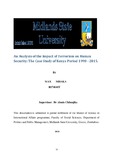Please use this identifier to cite or link to this item:
https://cris.library.msu.ac.zw//handle/11408/3896| Title: | An Analysis of the impact of terrorism on human security: the case study of Kenya period 1990 - 2015. | Authors: | Mhaka, Max | Keywords: | terrorism human security Kenya |
Issue Date: | 2018 | Publisher: | Midlands State University | Abstract: | This study seeks to analyse the impact of terrorism on human security, a case study of Kenya in the Period 1990 – 2015. The deterioration in the levels of human security in Kenya as a result of terrorism is the fundamental problem underscoring this research study. Guided by the Frustration–Aggression–Displacement theory, as espoused by John Dollard 1961; and Leonard Berkowitz in 1969, this study understands a terrorist to be a frustrated individual seeking to remove the initial cause of this frustration by achieving the political goal which hitherto been denied by circumstances. The Al Shabaab group is identified as the main terrorist group threatening peace and security in Kenya. The study employs the interview method and document analysis as key research tools. It concludes that the impact of terrorism in Kenya has resulted in a trade off between state security and human security as a result of both internal and external factors. The study therefore recommended that, in Kenya, terrorism has to be combated by a combination of government, governance, stringent laws and a firm system of justice that delivers ‘appropriate’ punishments to the perpetrators. It further recommended that the government, the security forces and religious and political leaders including the civil community should work in harmony to prevent terrorism. | URI: | http://hdl.handle.net/11408/3896 |
| Appears in Collections: | Master of Science in International Affairs Degree |
Show full item record
Page view(s)
264
checked on Jan 18, 2026
Download(s)
150
checked on Jan 18, 2026
Google ScholarTM
Check
Items in MSUIR are protected by copyright, with all rights reserved, unless otherwise indicated.




